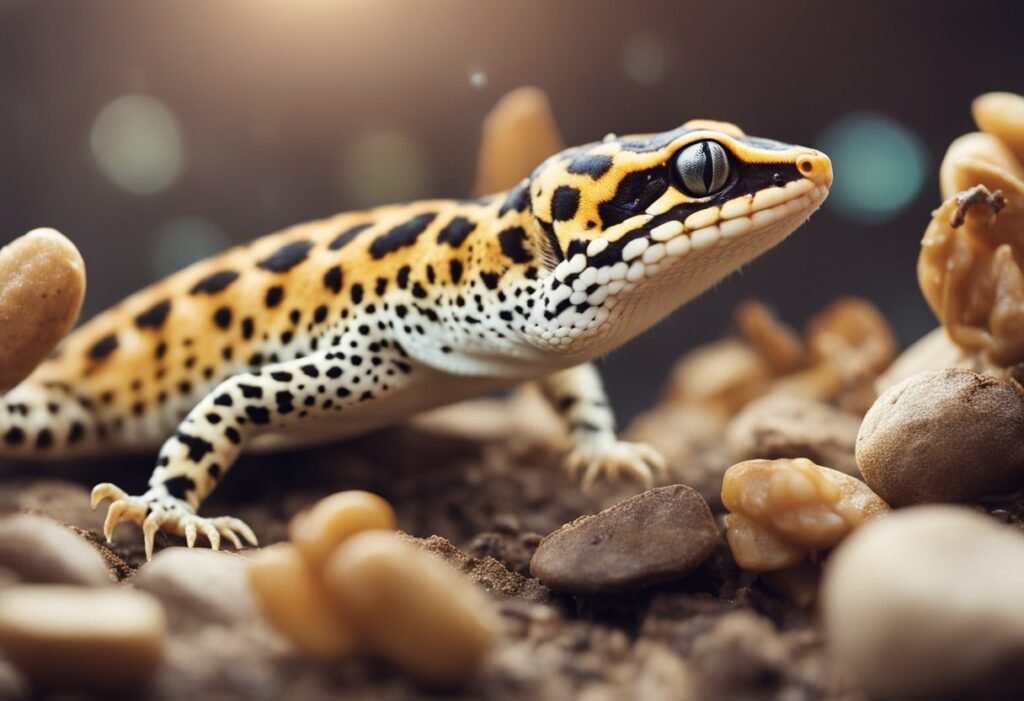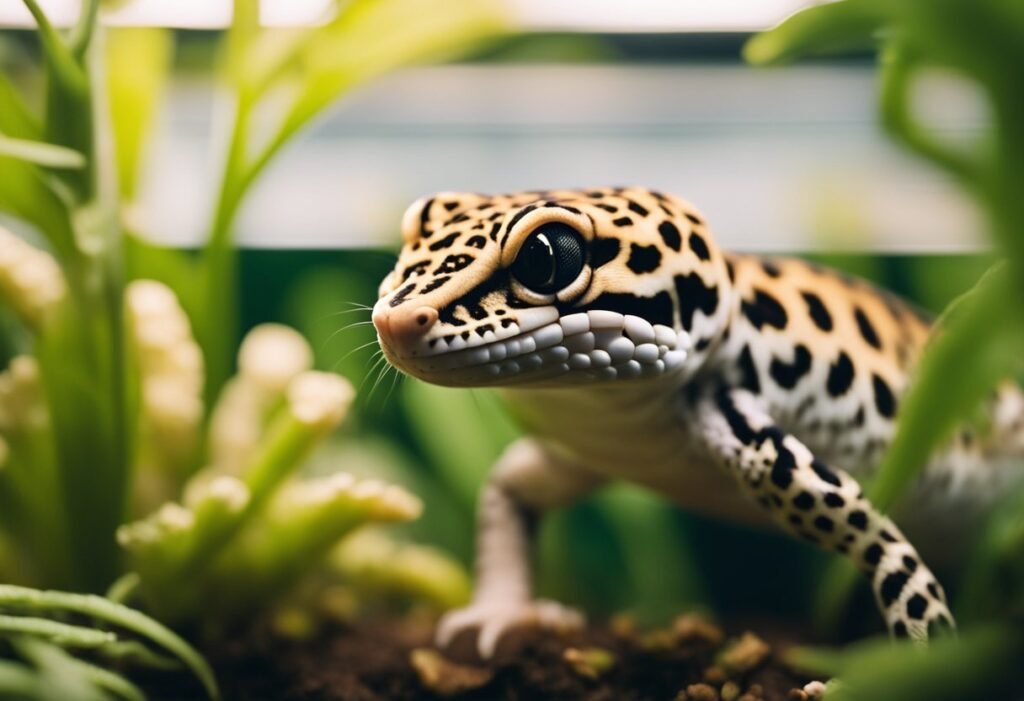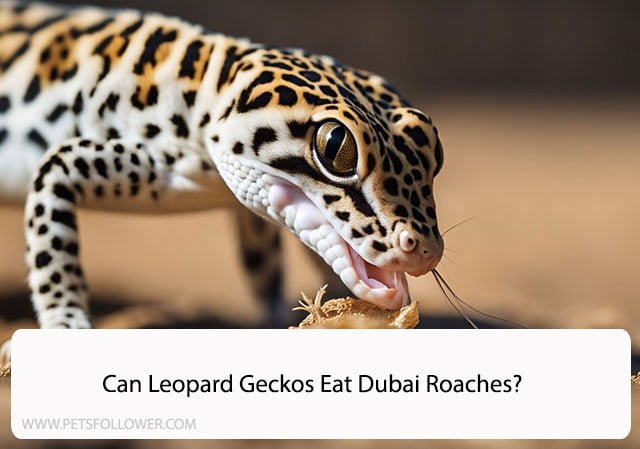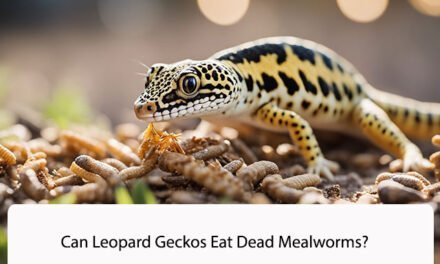Leopard geckos are popular pets for reptile enthusiasts due to their unique appearance and easy care. As with any pet, it’s important to provide them with a balanced and nutritious diet. One food source that has gained popularity in recent years is Dubai roaches, also known as Turkestan roaches. But can leopard geckos eat Dubai roaches?
The answer is yes, leopard geckos can eat Dubai roaches. In fact, Dubai roaches are a great source of protein and other nutrients for leopard geckos. They are also easy to digest and less likely to carry parasites than other feeder insects. However, it’s important to ensure that the Dubai roaches are properly gut-loaded and dusted with calcium and other supplements before feeding them to your leopard gecko.
In this article, we will explore the benefits and potential risks of feeding Dubai roaches to leopard geckos. We will also provide tips on how to properly prepare and feed Dubai roaches to ensure the health and well-being of your leopard gecko.
Nutritional Benefits of Dubai Roaches

Dubai roaches are a popular feeder insect for leopard geckos due to their high nutritional value. Here are some of the key nutritional benefits that make Dubai roaches a great addition to your leopard gecko’s diet.
Protein Content
Dubai roaches are a great source of protein, which is essential for the growth and maintenance of your leopard gecko’s muscles, organs, and tissues. In fact, they contain a higher percentage of protein compared to other common feeder insects such as crickets and mealworms. This makes them an ideal choice for leopard geckos that require a high-protein diet, such as growing juveniles or breeding adults.
Calcium to Phosphorus Ratio
Dubai roaches have a favorable calcium to phosphorus ratio, which is important for maintaining healthy bones and preventing metabolic bone disease in leopard geckos. They contain more calcium than phosphorus, which is ideal for leopard geckos since they require a high-calcium diet. However, it’s important to note that the calcium to phosphorus ratio can vary depending on the diet of the Dubai roaches, so it’s important to feed them a balanced diet as well.
Vitamins and Minerals
Dubai roaches are also a good source of vitamins and minerals that are essential for the overall health of your leopard gecko. They contain high levels of vitamin B12, which is important for nerve function and the production of red blood cells. They also contain significant amounts of vitamin A, vitamin E, and iron, which are important for maintaining healthy skin, eyes, and immune function. Additionally, they are a good source of potassium, magnesium, and zinc, which are important for various metabolic processes in the body.
Overall, Dubai roaches are a highly nutritious feeder insect that can provide a range of essential nutrients for your leopard gecko. However, it’s important to ensure that they are fed a balanced diet and that their nutritional needs are met to ensure optimal health and wellbeing.
Feeding Leopard Geckos Dubai Roaches

Dubai roaches, also known as Turkestan roaches, are a popular live food option for leopard geckos. They are a nutritious and easy-to-digest food source that can help keep your leopard gecko healthy and happy. In this section, we will discuss appropriate sizing, frequency of feeding, and live prey feeding techniques when it comes to feeding leopard geckos Dubai roaches.
Appropriate Sizing
When feeding Dubai roaches to your leopard gecko, it is important to choose the appropriate size. Generally, you should choose roaches that are no larger than the width of your leopard gecko’s head. This ensures that the roaches are easy to digest and won’t cause any choking hazards.
Frequency of Feeding
Leopard geckos should be fed every other day, and Dubai roaches can be a part of their regular diet. However, it is important to vary their diet with other live insects such as crickets, mealworms, and waxworms. This will help ensure that your leopard gecko is getting a balanced and varied diet.
Live Prey Feeding Techniques
When feeding Dubai roaches to your leopard gecko, you can either place them directly in the enclosure or use feeding tongs. Feeding tongs can be useful for keeping your hands away from your leopard gecko’s mouth and preventing accidental bites. It is also important to make sure that the roaches are alive and moving, as this will stimulate your leopard gecko’s hunting instincts.
Overall, Dubai roaches can be a nutritious and beneficial addition to your leopard gecko’s diet. By following appropriate sizing, frequency of feeding, and live prey feeding techniques, you can ensure that your leopard gecko is getting the best possible nutrition and care.
Preparing Dubai Roaches for Feeding

When it comes to feeding leopard geckos, Dubai roaches can be an excellent choice. However, it is important to properly prepare them to ensure that they are safe and nutritious for your pet. In this section, we will discuss the steps you should take to prepare Dubai roaches for feeding.
Gut Loading
Dubai roaches, like all feeder insects, require proper nutrition to provide your leopard gecko with the nutrients it needs. Gut loading is the process of feeding the insects a nutritious diet before feeding them to your pet. This ensures that your leopard gecko is receiving a well-rounded diet.
We recommend feeding your Dubai roaches a high-quality gut load for at least 24 hours before feeding them to your leopard gecko. Some great options for gut loading include fresh fruits and vegetables, commercial gut loading diets, and dry dog food.
Dusting with Supplements
In addition to gut loading, it is important to dust your Dubai roaches with supplements before feeding them to your leopard gecko. This helps ensure that your pet is receiving all of the necessary vitamins and minerals it needs to stay healthy.
We recommend dusting your Dubai roaches with a calcium supplement at least once a week. You can also dust them with a multivitamin supplement once a month. Be sure to follow the instructions on the supplement packaging for proper dosing.
Safe Storage and Handling
Proper storage and handling of Dubai roaches is crucial for ensuring their safety and nutritional value. We recommend storing your Dubai roaches in a well-ventilated container with a secure lid. This will help prevent escape and ensure that they stay fresh.
When handling Dubai roaches, be sure to wash your hands thoroughly before and after. This will help prevent the spread of bacteria and other harmful substances.
By following these steps, you can ensure that your Dubai roaches are safe and nutritious for your leopard gecko to eat.
Health Considerations
When considering feeding Dubai roaches to leopard geckos, there are several health considerations to keep in mind. In this section, we will discuss the potential risks associated with feeding these roaches to your gecko.
Risk of Impaction
One of the primary concerns when feeding any prey item to a leopard gecko is the risk of impaction. Dubai roaches are relatively large insects, and if they are not properly chewed, they can cause blockages in the gecko’s digestive system. This can lead to serious health problems, including death.
To minimize the risk of impaction, it is important to ensure that the roaches are an appropriate size for your gecko and that they are properly gut-loaded and hydrated. Additionally, we recommend feeding roaches in moderation and monitoring your gecko’s feces for any signs of digestive issues.
Allergy and Sensitivity Issues
Another potential health concern is allergy and sensitivity issues. Some leopard geckos may be allergic or sensitive to certain types of prey items, including Dubai roaches. Symptoms of an allergic reaction may include swelling, itching, and difficulty breathing.
If you notice any signs of an allergic reaction after feeding your gecko Dubai roaches, we recommend discontinuing their use and consulting with a veterinarian.
Parasite Transmission
Finally, it is important to be aware of the potential for parasite transmission when feeding any type of prey item to your leopard gecko. Dubai roaches, like all insects, can carry a variety of parasites, including mites and intestinal worms.
To minimize the risk of parasite transmission, we recommend purchasing roaches from a reputable supplier and thoroughly inspecting them before feeding them to your gecko. Additionally, we recommend consulting with a veterinarian to develop a parasite prevention and treatment plan for your gecko.
In summary, while Dubai roaches can be a nutritious and beneficial prey item for leopard geckos, it is important to consider the potential health risks associated with their use. By following proper feeding and care protocols, you can help ensure that your gecko remains happy and healthy.
Alternatives to Dubai Roaches
If you are looking for alternative food options for your leopard gecko, there are a few options to consider. Here are some of the most common alternatives to Dubai roaches:
Mealworms
Mealworms are a popular choice for leopard gecko owners. They are readily available at most pet stores, and they are relatively inexpensive. Mealworms are also easy to store and can be kept in the refrigerator for several weeks.
One thing to keep in mind when feeding mealworms to your leopard gecko is that they are high in fat. As a result, they should be fed in moderation to prevent your gecko from becoming overweight.
Crickets
Crickets are another common food option for leopard geckos. They are high in protein and are a good source of nutrition for your gecko. Crickets are also easy to find at most pet stores and can be purchased in bulk.
One thing to keep in mind when feeding crickets to your leopard gecko is that they can be noisy. If you are sensitive to noise, you may want to consider another food option.
Waxworms
Waxworms are a tasty treat that many leopard geckos enjoy. They are high in fat and should be fed in moderation, but they can be a good source of nutrition for your gecko.
One thing to keep in mind when feeding waxworms to your leopard gecko is that they are not as nutritious as other food options. As a result, they should be fed as a treat rather than a regular part of your gecko’s diet.
Overall, there are several alternatives to Dubai roaches that you can consider when feeding your leopard gecko. Each option has its own benefits and drawbacks, so it’s important to do your research and choose the best option for your gecko’s needs.
Frequently Asked Questions
What is the appropriate size of Dubia roaches to feed a leopard gecko?
Dubia roaches should be appropriately sized for the leopard gecko to consume easily. For juvenile leopard geckos, small Dubia roaches (1/4 inch to 1/2 inch) are suitable, while adult leopard geckos can consume larger Dubia roaches (1 inch to 1 1/2 inches).
How often should leopard geckos be fed Dubia roaches?
Leopard geckos should be fed Dubia roaches 2-3 times a week. Younger geckos may require more frequent feedings, while adult geckos may require less frequent feedings.
Are there any risks associated with leopard geckos eating Dubia roaches?
Dubia roaches are considered safe for leopard geckos to consume. However, if the roaches are not properly gut-loaded, they may lack essential nutrients and vitamins that the geckos need.
Can Dubia roaches be left in the leopard gecko tank overnight?
It is not recommended to leave Dubia roaches in the leopard gecko tank overnight as they can crawl on the gecko and cause stress or even bite the gecko. It is best to remove any uneaten Dubia roaches after feeding.
Do leopard geckos prefer Dubia roaches over other insects?
Leopard geckos may have individual preferences, but Dubia roaches are generally considered a nutritious and tasty food source for them. It is important to provide a variety of insects in their diet to ensure they receive a balanced diet.
What nutritional value do Dubia roaches provide to leopard geckos?
Dubia roaches are a great source of protein, calcium, and other essential nutrients for leopard geckos. They are also low in fat and easy to digest, making them an ideal food source for these reptiles.





